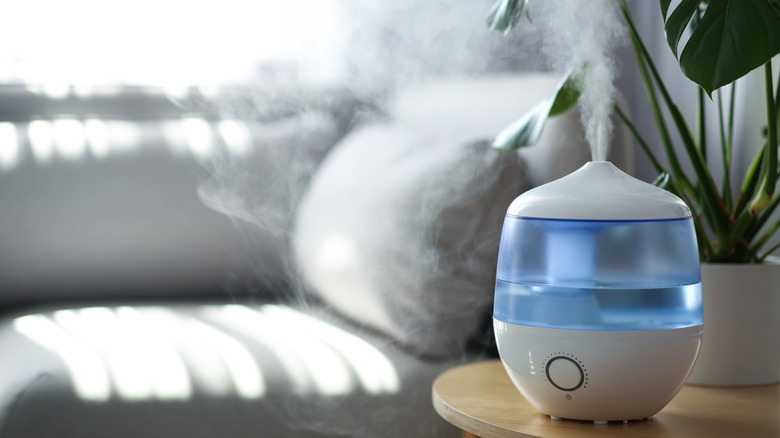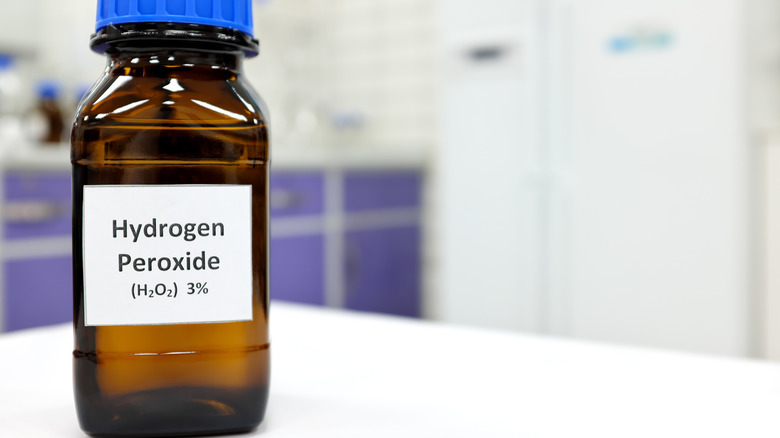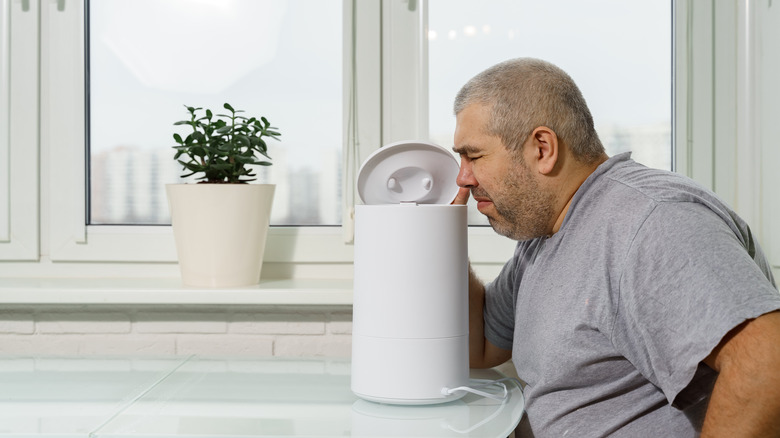Give Your Humidifier The Clean Of A Lifetime With This Handy Home Essential
It may not be common knowledge for occasional users, but humidifiers can be an air quality disaster if they're not cleaned regularly... and properly. That's not an overstatement. Humidifiers can spread mold and disease as if they are built to do just that. The good news is that you probably already have everything you need to give your humidifiers a good cleaning: regular 3% hydrogen peroxide does the trick, and it's available just about everywhere. The other half of the equation, of course, is making sure you do the cleaning the right way to avoid the hidden downsides of humidifiers.
Improperly cleaned humidifiers have been associated with many health risks. Contrary to the belief that cool mist humidifiers kill germs in your home, they actually aerosolize anything you might put in the water, from mold to outbreaks of Mycobacterium chelonae, which is most often found in tap water. According to the Centers for Disease Control, humidifiers and any other devices containing non-sterile water can harbor Legionella, which causes Legionnaires' disease, and humidifiers have been documented as the cause of outbreaks of Legionnaires' and other diseases. These are dangerous for everyone, but immunocompromised people and babies are at extreme risk.
How to clean your humidifier
Proper cleaning starts with frequency. While manufacturers and other sources might advise you to clean your device weekly or even every three days, the CDC encourages daily cleaning of a humidifier that's in use. It's not a particularly difficult task, but you will need to empty the tank and scrub to remove any mineral buildup, which contributes to germ growth. To deep clean your humidifier, pour a solution of four parts water to one part hydrogen peroxide into the tank and undiluted hydrogen peroxide into the base, then scrub with an appropriately sized brush. Allow the base and tank to sit with the hydrogen peroxide for 30 minutes, then empty, rinse, and allow all pieces to air dry if possible. Remove and clean your humidifier's disposable wick, if it has one, by rinsing it thoroughly. If you can't remove mineral buildup from this wicking pad, replace it with a new one. Don't forget to wear gloves when using hydrogen peroxide to clean.
After it's clean and dry, you can safely refill and use your humidifier. It's best to avoid tap water, and it is often recommended to operate a humidifier with distilled water or tap water that has been boiled and then cooled. A 2021 CDC study found that even people who understand that tap water is not sterile will frequently use it in devices like humidifiers, even though it is dangerous for those (and other) uses. It's still safe to use as drinking water.
What not to do when cleaning a humidifier
Rinsing the base and tank is important to prevent other chemicals — in this case, hydrogen peroxide — from getting airborne in your environment and causing other health problems. So, it is obviously not a great idea to follow the advice you'll occasionally see online to operate your humidifier with a hydrogen peroxide (or bleach) solution in its tank. Low levels of aerosolized hydrogen peroxide can cause stinging pain in the eyes, airway irritation, shortness of breath, and other symptoms. In some circumstances, it can even cause asphyxiation. Breathing higher concentrations can cause severe congestion, accumulation of fluid in the lungs, permanent damage to the central nervous system, and even death.
You can run a peroxide solution through your humidifier and shut it off before vapor is released, but this practice must only take place outdoors. While a thorough cleaning prolongs the life of your humidifier, it might also introduce new contaminants. Rinse and operate the device with distilled water afterwards if you do decide to do this outdoor cleaning. Running a peroxide solution through your humidifier is thought to extend its usage because it helps disinfect hard-to-clean portions of the machine. Unfortunately, this isn't a long-term solution because of the inevitability of long-term mineral buildup. If your humidifier has residue even after cleaning it, it should be replaced. You'll want to replace your humidifier regardless every few years at a minimum.


